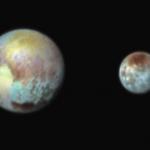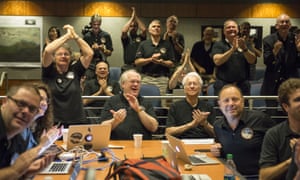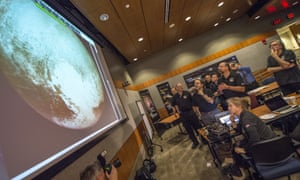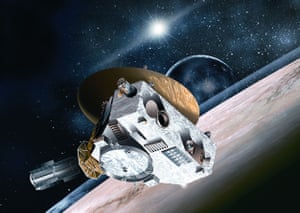Pluto Flyby Photos Thrill New Horizons Scientists After Nine-Year Nasa Mission

Cheers, whoops and flag waving broke out at Nasa’s New Horizons control centre as scientists celebrated the spacecraft’s dramatic flyby of Pluto, considered the last unexplored world in the solar system.
The probe shot past at more than 28,000mph (45,000 km/h) at 12.49pm BST (7.49am ET) on a trajectory that brought the fastest spacecraft ever to leave Earth’s orbit within 7,770 miles of Pluto’s surface.
The moment, played out on Tuesday to the sound of The Final Countdown by the 1980s glam metal band Europe, marked a historic achievement for the US, which can now claim to be the only nation to have visited every planet in the classical solar system.
Members of the New Horizons science team react to seeing the probe’s last and sharpest image of Pluto before its closest approach. Photograph: Bill Ingalls/AP
“It feels good,” said Alan Stern, lead scientist on the mission. “So many people put so much work into this around the country. We’ve completed the initial reconnaissance of the solar system, an endeavour started under President Kennedy.”
John Grunsfeld, head of Nasa’s science mission directorate, said that images beamed back from New Horizons on its approach showed Pluto to be an “extraordinarily interesting and complex world”.
“It’s just amazing. It’s truly a hallmark in human history,” he said of the encounter with Pluto. “It’s been an incredible voyage.”
Stephen Hawking, the Cambridge cosmologist, joined in congratulating the New Horizons team in a recorded message. “Billions of miles from Earth this little robotic spacecraft will show us that first glimpse of mysterious Pluto, a distant icy world on the edge of our solar system. The revelations of New Horizons may help us to understand better how our solar system was formed. We explore because we are human and we long to know,” he said.
Bristling with cameras and other instruments, the New Horizons probe was programmed to gather a wealth of images and data as it sped past Pluto and its five small moons, Charon, Styx, Nix, Hydra and Kerberos.
Images beamed back from New Horizons have shown Pluto in shades of red and orange, with hints of valleys, mountains and craters. On Tuesday Nasa released a new image of Pluto. The picture was taken at about 9pm BST (4pm ET) on 13 July, about 16 hours before the moment of closest approach. The spacecraft was 476,000 miles from the surface.
Though Pluto has a varied terrain, with dark patches on the equator and brighter regions to the north, its surface looks younger and smoother than that of its largest moon, Charon. The reason may be geological activity, which refreshes the body’s surface.
Sensors on New Horizons detected Pluto’s thin nitrogen atmosphere extending far out into space. Scientists believe it may shed snow, with flakes tumbling down to the surface before vaporising back into the atmosphere.
Other measurements from the probe have found that Pluto is larger than previously thought, at 1,470 miles across. That means it contains more ice beneath its surface and less rock than scientists had anticipated.
Members of the New Horizons team view the spacecraft’s last and sharpest image of Pluto before its closest approach. Photograph: Bill Ingalls/AP
Mission scientists at Johns Hopkins University in Baltimore were out of contact with the spacecraft as it hurtled past the icy body 3bn miles from Earth. Instead the probe captured images and took measurements automatically and stored them on board to send back later.
Alice Bowman, missions operations manager, said that when the spacecraft fell silent on Monday, as expected, scientists stayed in the operations centre. “We wanted to be with it,” she said. “We always talk about the spacecraft being a child, a baby, a teenager. We lost signal as planned last night, and there was nothing anybody on the operations team could do but trust we’d prepared it well.”
At such a great distance, direct control from the ground is impossible, because radio signals take more than nine hours to travel to the spacecraft and back again. It will take 16 months to beam all of New Horizon’s data back to Earth.
Scientists now face an agonising wait for news from the spacecraft, which is due to call home at 2am BST Wednesday (9pm ET Tuesday). Only when that 15 minute-long signal is received will Nasa officials know whether New Horizons survived the flyby.
One of the greatest hazards the spacecraft faces is dust that may form a hazy cloud around Pluto after being knocked off its moons by meteorite strikes. Hal Weaver, a scientist on the mission, said that colliding with a dust particle the size of a grain of rice could potentially destroy the mission. But the risk of such a catastrophic failure was low, at less than one in 10,000.
“I am feeling a little bit nervous, but I have absolute confidence it’s going to do what it needs to do, and turn around and send us that burst of data,” Bowman said.
Stern was equally confident that New Horizons would survive the flyby: “I don’t think we’re going to lose the spacecraft.”
The loss would be tremendous, should it happen. About 99% of the data is still on the spacecraft. “Some of the most important stuff is in that. It would be a great disappointment if New Horizons is lost,” Stern said.
New Horizons blasted off in January 2006, carrying the ashes of Clyde Tombaugh, the astronomer who discovered Pluto in 1930. Several months later, astronomers at the International Astronomical Union voted to change the definition of the word “planet”, a move that downgraded Pluto to the more diminutive “dwarf planet”. The flyby may resurrect the debate and see Pluto restored to full planetary status.
In a live interview on Nasa TV on Tuesday, Charles Bolden, Nasa’s chief administrator, said he hoped the scientists would reconsider the name. “I call it a planet, but I’m not the rule maker,” he said, adding that arguments over Pluto’s status should not detract from the achievement. “It should be a day of incredible pride.”
Artist’s impression of the New Horizons spacecraft. Photograph: Johns Hopkins University/PA
Pluto lies in a region of space at the edge of the solar system called the Kuiper belt. Astronomers call it the third zone of space. The first zone contains the rocky, terrestrial planets of Mercury, Venus, Earth and Mars. The second zone is home to the gas giants, Jupiter, Saturn, Uranus and Neptune. Alongside the Pluto system in the Kuiper belt are comets and more than 100,000 miniature worlds.
New Horizons is expected to continue its mission into the Kuiper belt. The spacecraft is powered by a nuclear generator that runs on plutonium, a substance named after the dwarf planet. The generator should run until the 2030s, when New Horizons will be 100 times further away than Earth is from the sun.



